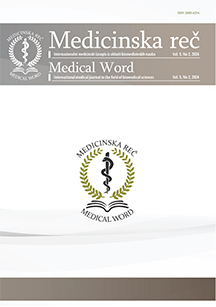Antibacterial Acitivity of Esssential Oils of Selected Medicinal Plants on the Causative Agents of Respiratory Infections in Pediatric Population
Abstract
Acute respiratory infections (ARI) are the most common infectious diseases today and are the reason for as many as 75% of prescribed antibiotics in the world. For this reason, ARI is responsible for the emergence of bacterial resistance to the most commonly used antibiotics.
The paper aimed to examine the potential antibacterial activities of the essential oil of medicinal plants Lavandula angustifolia Mill., Mentha spicata L., Chamomilla recutita (L.) Raushert, Salvia officinalis L., Urtica dioica L., from the region of southeastern Serbia, on bacteria associated with respiratory infections in the pediatric population.
Relevant, dichotomous keys were used to determine the plant material. The extraction of the essential oil was performed with a Clevenger-type apparatus, while the antibacterial activity was examined with an aromatogram, using the disk-diffusion method. Statistical analysis was performed with a one-factor ANOVA test.
The use of essential oils can be an alternative solution to combat multidrug-resistant bacteria. In our research, the oil of Salvia officinalis L. showed the strongest inhibitory effect against Moraxella sp., while the oil of Chamomilla Recutita (L.) Raushert showed the weakest effect against Haemophilus sp. In general, the essential oil of Chamomilla recutita (L.) Raushert showed the weakest effect against all isolated pathogens.
The essential oil of the investigated plants can be used as a potential source of natural antibacterial compounds. Because of all the above, it is necessary to further investigate and identify the biologically active compounds of the investigated plants.
References
World Health Organization. The top 10 causes of death. World Health Organization; 2020 [pristupljeno 30.05.2023.]. Dostupno na: http://www.who.int/news-room/fact- sheets/detail/the-top-10-causes-of HYPERLINK “http://www.who.int/news-room/fact-sheets/detail/the-top-10-causes-of death”
Calderaro A, Buttrini M, Farina B, Montecchini S, De Conto F, Chezzi C. Respiratory Tract Infections and Laboratory Diagnostic Methods: A Review with A Focus on Syndromic Panel-Based Assays. Microorganisms 2022; 10(9): 1856.
World Health Organization. Acute respiratory infections: the forgotten pandemic: Communique from the International Conference on Acute Respiratory Infections, held in Canberra, Australia, 7-10 July 1997. Int J Tuberc Lung Dis 1998; 2(1): 2-4.
Bagić M. Obilježja i ishodi sindroma teške akutne respiratorne infekcije kao pokazatelji teških oblika influence. Diplomski rad. Sveučilište u Zagrebu, Medicinski fakultet. 2018.
Niederman MS, Torres A. Respiratory infections. Eur Respir Rev 2022; 31: 220150.
Simoes EAF, Cherian T, Chow J, et al. Acute Respiratory Infections in Children. In: Disease Control Priorities in Developing Countries. 2nd ed. The International Bank for Reconstruction and Development / The World Bank, Washington (DC); 2006.
Black RE, Morris SS, Bryce J. Where and Why Are 10 Million Children Dying Every Year? Lancet 2003; 361(9376): 2226–34.
Williams BG, Gouws E, Boschi-Pinto C, Bryce J, Dye C. Estimates of Worldwide Distribution of Child Deaths from Acute Respiratory Infections. Lancet Infect Dis 2002; 2: 25–32.
Bryce J, Boschi-Pinto C, Shibuya K, Black RE; WHO Child Health Epidemiology Reference Group. WHO Estimates of the Causes of Death in Children. Lancet 2005; 365: 1147–52.
Cars O, Mölstad S, Melander A. Variation in antibiotic use in the European Union. Lancet 2001; 357: 1851-3.
Tutin TG, Heywood VH, Burges NA, Moore DM, Valentine DH, Walters SM, Webb DA (eds). 1964-1980: Flora Europaea, I-V. Cambridge University Press, London.
Josifović, M. (ed) (1970–1980): Flora of Serbia I-X. SANU, Belgrade Interpretation Manual of European Union Habitats. 1999. version EUR 15/2.
Euro+Med 2006: Euro+Med Plant Base - the information resource for Euro Mediterranean plant diversity. Published on the Internet http://ww2.bgbm.org/EuroPlusMed/
European Pharmacopoeia, 8th ed. vol 1. Ph. Eur. 8.1. Strasbourg: Council of Europe (EDQM); 2013.
Boukhatem MN, Ferhat MN, Kameli A, Saidi F, Taibi H, Djamel T. Potential application of thyme (Thymus vulgaris L.) Essential oil as antibacterial drug in aromatherapy. Int J Innov Appl Stud 2014: 8(4): 1418-31.
Soković M, Marin PD, Brkić D, van Griensven D, L.J.L.D. Chemical composition and antibacterial activity of essential oils of ten aromatic plants against human pathogenic bacteria. Food. 2007:1.
Ramtin M, Massiha A, Khoshkholgh-Pahlaviani MRM, Issazadeh K, Assmar M, Zarrabi S. Evaluation of the antibacterial activities of essential oils of Iris pseudacorus and Urtica dioica. Zahedan J Res Med Sci (ZJRMS) 2014; 16 (3): 35-9.
Zaidi S, Dahiya P. In vitro antimicrobial activity, phytochemical analysis and total phenolic content of essential oil from Mentha spicata and Mentha piperita. Int Food Res J 2015; 22 (6): 2440-5.

